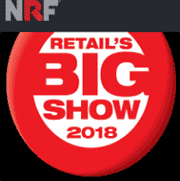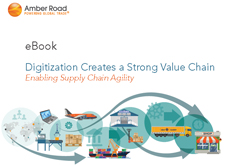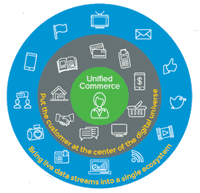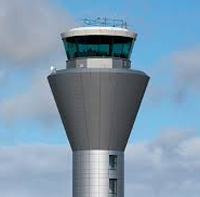NRF Big Show 2018 in New York City
Ok, I am just back from the National Retail Federation's Big Show at the Javitz Center in New York City. Thousands of you have watched my Day 1 and Day 2 video review and summary pieces, while today I wrap up our coverage with a written trip report. I will note as usual that next week we will be breaking the long longer full day video summaries into individual solution clips so that readers can view just what solutions most interest them.
Despite the turmoil in much of retail right now – or maybe more accurately because of it – this show continues to be red hot. NRF says 36,000 attendees signed up this year, a modest increase from 35,000 in 2017, but up is up in this trade show environment. It's a game of survival now for many retailers, and technology is a critical part of the game plan for many/most right now.
| GILMORE SAYS: |
My usual question: can we "X-ray" a pallet full of cartons going by an RFID reader yet. The answer: sort of.
WHAT DO YOU SAY?
Send us your
Feedback here
|
Last year, it finally struck me that the key "theme" for the show was IBM's Watson computer and its application of artificial intelligence to a variety of retail and supply chain problems. "What IBM is up to is a threat to any software vendor that provides decision support tools, and a look into a very brave new software world," I wrote then.
Well of course IBM was back with more Watson, and there was certainly an emphasis by a number of vendors on use of AI, as I will explain in a second.
So I have no overarching theme, but will note these four general trends:
First, just about all development is now is for Cloud and mobile. As just one example, Zebra had a software partner in its booth with a very broad portfolio of in-store solutions – from customer interaction to in-store efulfillment - that was 100% mobile-based. There simply is no traditional desk top version of the software.
Also in the Zebra booth was actually Target stores, promoting all the tools they are providing to customers and associates. The retail giant has an IT team cranking out what it calls "functions" (not apps), and if I got it right those are being rolled out like one per week. Meanwhile, some Target developers are focused on building tools the function programmers can use (e.g., a screen flow tool) that further speeds mobile development.
This is simply where we are heading, rapidly, and in retail and beyon if this isn't baked into your IT strategy then it is time to relook at that roadmap. Among the many implications from this trend is the transition to subscription-based costs from the traditional up front license pricing, a big change indeed (both positive and negative)
Second, over the past few years, a significant number of vendors have promoted use of "advanced analytics" to address a wide spectrum of issues. This trend is actually quite impactful – the use of analytics is really a different approach to supply chain planning, and enables, for example, much greater consideration of so-called causal factors in developing a forecast.
I spoke at the show with Logility president Allan Dow on this topic, and he referenced as an example the ability of these new tools to gather insight from unstructured content coming through on social media to identify trends that could impact the forecast.
My question is really whether analytics will be "additive" to current planning technologies – that's Dow's opinion – or ultimately upend or replace those technologies. That remains to be seen, in my opinion.
My main point here is that at NRF 2018 much of that prior emphasis on advanced analytics has morphed into a focus on AI and machine learning. Is that a real technology change or just one of terminology? A little of both. The machines are simply getting scarily smart.
The third trend simply has to do with the growing role – indeed criticality - of Distributed Order Management (DOM) in omnichannel retail and beyond (from IBM, Manhattan, Softeon and others). It is actually quite remarkable, if you think about it: we now have a tool that enables companies to define in detail the logic behind how their entire networks will operate, and flexibly make changes to those strategies over time.
We simply have never had a tool quite like this in the supply chain before, operating with granular visibility into inventory and constraints across the network, then leveraging a rules engine to execute the plan. This is actually quite cool, and I will note DOM has many other use cases beyond omnichannel fulfillment.
And my final theme is the focus on "platforms," roughly meaning vendors with a truly common architecture in which some group of applications can operate seamlessly, and which provides a common integration point for existing or external applications. That in contrast to more "point solutions" that must be stitched together, even if from one vendor.
I am all for platforms, but will just day this: there are true platforms, and then there are what we might called pseudo-platforms, regardless of what the signage on the booth says. Therefore, proceed with caution and some healthy vendor skepticism.
With that overview, it doesn't leave me much room for highlighting the best new solutions I saw, but here it goes, noting all these and more are covered in the Day 1 and Day 2 videos.
 Digimarc is an interesting provider of technology for invisibly embedding a bar code in a product's packaging, as we have covered previously. At this show it also featured a concept solution for printing a Digimarc bar code right on the corrugate of a shipping carton (either a SKU case code or serial number like a GS1128). Digimarc is an interesting provider of technology for invisibly embedding a bar code in a product's packaging, as we have covered previously. At this show it also featured a concept solution for printing a Digimarc bar code right on the corrugate of a shipping carton (either a SKU case code or serial number like a GS1128).
Why would a company want to do this? So that the bar code – in this application barely visible as tiny black dots on the cardboard – can be scanned from all sides and angles, and can be read even if the carton is severely damaged. That could be very useful for lift truck drivers or in automated systems. There are still many questions here, but this was cool, and we will follow the progress.
Next, I continue to believe that vision systems will in the end be key to solving part of the out-of-stock problem in retail – the part where the inventory is actually in the store, just not on the shelf.
There were several vendors at the show tackling this opportunity from different angles. SES Imagotag says its system just learns what a product's packaging is, without the need to preload the images as most others do. It then uses electronic shelf labels (its main business) to understand the planogram, and thus report out-of-stocks based on images taken by a store's cameras.
A company called Smart Shelf takes a different approach, actually placing a 180-degree camera in the back of the shelf that visually monitors inventory levels and sends out alerts. But it also has a front camera that tracks people and their demographics coming up to the shelf and launches promotional messages and videos based on that data. The company claims a test with Hershey and Walmart in I believe five stores led to large bumps in sales from the combination of fewer stockouts and the promotions.
Finally, Bossanova has a robot that walks the aisles right along with customers, using an imager to monitor inventory and even pricing discrepancies. In 2017, Walmart announced it was testing these robots in 50 stores. Meanwhile, Bossanova has added an RFID reader to the robot, as imaging works well for many items, but not say for a stack of dish towels, which RFID can address.
I really like the array of automated storage systems from Apex Supply Chain Technologies, which at this show emphasized a series of locker systems for ecommerce pick-up. Very attractive, I didn't realize there were so many options: indoors, outdoors, load and unload from the front, two-sides (load from back), etc.
Even better, Apex publishes all the usage data to the Cloud for analysis of behavior patterns, and now has developed a simulation tool that allows retailers to gain insight into options for locker configurations and placement in store. Apex will also lease locker banks for peak season.
RFID leader Impinj was demonstrating packing and truck loading applications using RFID. My usual question: can we "X-ray" a pallet full of cartons going by an RFID reader yet? The answer: sort of. Impinj says it works very reliably for up to 16-20 cartons. That's progress, but not enough for many applications.
I will quickly note the expansion of the IBM blockchain solution for tracking and digitizing cross border freight moves in partnership with Maesrk Line, and an interesting augmented reality order picking solution (using smart glasses) from Logistiview.
Lots more, but I am out of space. Please see the full day videos, or wait for the individual clips next week, for more on the most interesting solutions I found.
Any reaction to Gilmore's NRF Trip Report? Were you there? What caught your eye? Let us know your thoughts at the Feedback button below. |



![]()

![]()

![]()










 Digimarc is an interesting provider of technology for invisibly embedding a bar code in a product's packaging, as we have covered previously. At this show it also featured a concept solution for printing a Digimarc bar code right on the corrugate of a shipping carton (either a SKU case code or serial number like a GS1128).
Digimarc is an interesting provider of technology for invisibly embedding a bar code in a product's packaging, as we have covered previously. At this show it also featured a concept solution for printing a Digimarc bar code right on the corrugate of a shipping carton (either a SKU case code or serial number like a GS1128).

